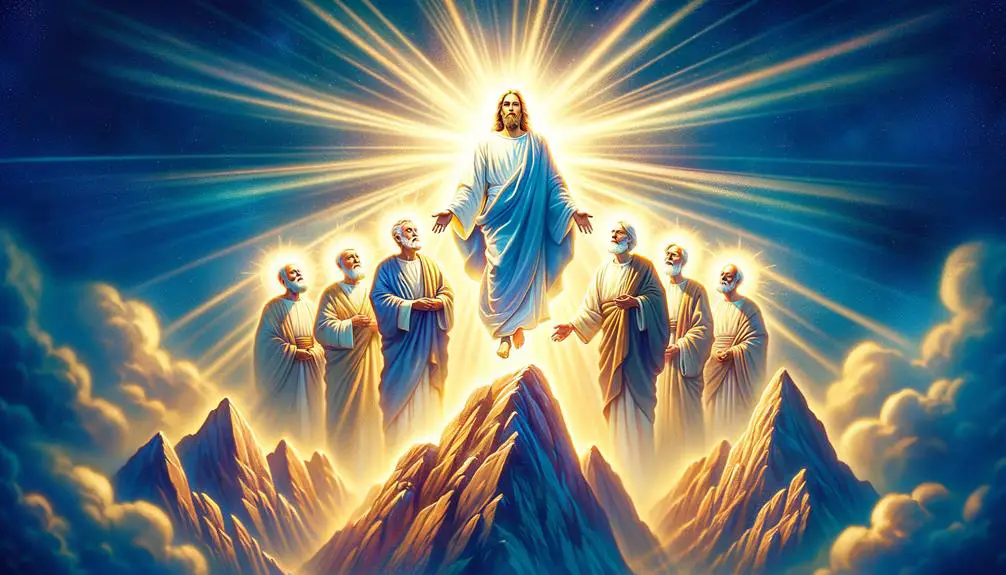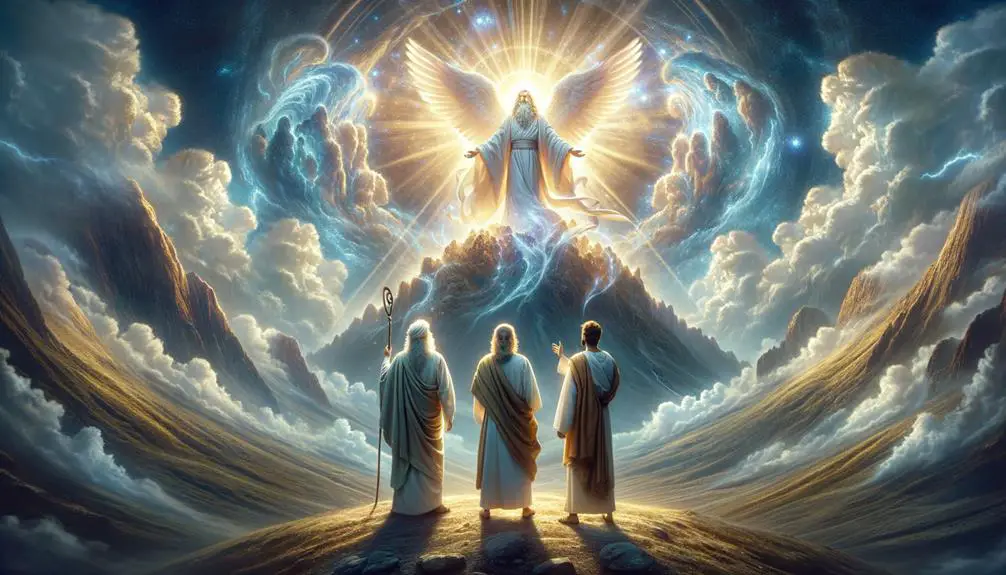Gain insight into the Transfiguration's location in Matthew, Mark, and Luke, and discover its profound impact on biblical narratives and theology.

Where Is the Transfiguration in the Bible
Did you know that three out of the four Gospels in the New Testament recount the event of the Transfiguration?
You'll find this pivotal moment in the Gospels of Matthew, Mark, and Luke, each offering a unique perspective on this miraculous occurrence.
It's a scene that not only dazzles with its description of divine transformation but also holds deep theological significance.
As you explore these accounts, you'll uncover layers of meaning that might reshape your understanding of this biblical event.
There's a rich tapestry of interpretations and implications waiting for you just beyond the surface.
Key Takeaways
- The Transfiguration is detailed in Matthew 17:1–9, Mark 9:2–8, and Luke 9:28–36.
- Each Gospel provides a unique perspective on the event, emphasizing its theological significance.
- The narratives include common elements such as a high mountain setting and a divine voice from a cloud.
- Moses and Elijah's appearance symbolizes the Law and the Prophets, highlighting the event's prophetic context.
Understanding the Transfiguration

To grasp the significance of the Transfiguration, it's essential to delve into the context and symbolism this pivotal event holds within the Christian narrative. You'll find that the historical context and prophetic symbolism deeply enrich your understanding of this momentous occasion.
In the historical context, the Transfiguration occurs after Jesus has been teaching, healing, and revealing His identity to His disciples. It's a period fraught with political tension and spiritual longing among the Jewish people, who yearn for the Messiah to free them from Roman oppression. This backdrop is crucial because it highlights the expectation of a savior and the prevailing misunderstandings about His mission.
The prophetic symbolism, on the other hand, is rich and multifaceted. The presence of Moses and Elijah during the Transfiguration isn't arbitrary. Moses represents the Law, and Elijah represents the prophets, both foundational elements of Jewish faith. Their appearance with Jesus, transfigured and radiating divine glory, symbolizes the fulfillment of the Law and the Prophets in Him. This moment underscores Jesus' divine authority and His role as the ultimate mediator between God and humanity.
Moreover, the Transfiguration serves as a foretaste of the Kingdom of God, providing a glimpse of the resurrected glory awaiting those who follow Jesus. It's a pivotal event that reassures the disciples of Jesus' divinity and His messianic mission, amidst the challenges and misunderstandings they face.
The Gospel of Matthew's Account
In the Gospel of Matthew, the account of the Transfiguration provides a vivid and detailed narrative that draws you into the heart of this transformative event. You're taken to a high mountain location, away from the multitudes, where the boundary between the divine and the earthly momentarily blurs. Here, Jesus is transfigured before Peter, James, and John, his face shining like the sun and his clothes becoming as white as light. This mountain location isn't just a backdrop; it's a pivotal setting that elevates the significance of what's unfolding.
The disciples' reaction to this celestial event is a mix of awe, fear, and bewilderment. As you delve into Matthew's account, consider these points:
- The Mountain as a Meeting Place with God: The choice of a mountain location isn't accidental. Mountains in biblical narratives often symbolize a closer proximity to God, a space where heaven and earth touch, and Matthew harnesses this symbolism to heighten the significance of the Transfiguration.
- The Disciples' Overwhelming Experience: Their reaction is profoundly human—fear, awe, and ultimately a reluctance to leave the mountain. This mirrors our own responses to encounters with the divine or moments of profound revelation.
- The Voice from the Cloud: This divine endorsement, 'This is my beloved Son, with whom I'm well pleased; listen to him,' not only affirms Jesus' identity but also instructs the disciples—and by extension, you—on the appropriate response to such a revelation.
Matthew's narrative, by focusing on these elements, invites you into a deeper contemplation of the Transfiguration's significance, both historically and spiritually.
Mark's Narrative on the Mountain

Shifting our focus to Mark's Gospel, we find another perspective on the Transfiguration that complements and deepens our understanding of this pivotal event. Within Mark's narrative, the elements of Moses' presence and Elijah's role aren't merely incidental; they're foundational, providing layers of meaning to the scene on the mountain.
You'll notice that Mark, much like Matthew, emphasizes Jesus' transformation in front of Peter, James, and John. Yet, it's the nuances in Mark's account that demand your attention. He places a significant emphasis on Moses' presence, signaling the law, and Elijah's role, representing the prophets. This isn't just a meeting of great figures; it's a symbolic convergence of law, prophecy, and the fulfillment they find in Jesus.
The inclusion of Moses and Elijah speaks volumes about Jesus' mission and identity. Mark wants you to see Jesus as the culmination of a long history of revelation, standing in continuity with the law (Moses) and the prophets (Elijah), yet also surpassing them. This transfiguration isn't just a miraculous display; it's a declaration of Jesus' unique position within God's unfolding plan.
Furthermore, Mark subtly uses this event to foreshadow the suffering that Jesus will endure, juxtaposing his divine glory with his impending human suffering. Through Moses' presence and Elijah's role, Mark crafts a narrative that's both a revelation of divine glory and a sober reminder of the path Jesus must walk.
In analyzing Mark's account, you're invited to ponder not just the event itself but its profound implications for understanding Jesus' identity and mission within the broader biblical narrative.
Luke's Detailed Description
Luke's Gospel offers a remarkably detailed account of the Transfiguration, inviting you to delve deeper into its theological significance. Unlike the other synoptic Gospels, Luke's narrative showcases his unique perspective, emphasizing the humanity and divinity of Jesus in a balanced and profound way. Through Luke's detailed description, you're able to grasp a fuller understanding of this pivotal event, where Jesus is transformed and speaks with Moses and Elijah.
Luke's account stands out for its narrative uniqueness, which includes:
- The Precise Context: Luke meticulously notes the timing of the event—about eight days after Jesus' prediction of his suffering and death, providing a temporal context that frames the transfiguration as a preparation for the ordeal to come.
- The Role of Prayer: Unlike the other Gospels, Luke specifies that the Transfiguration occurred while Jesus was praying. This emphasis on prayer highlights Jesus' intimacy with the Father, underscoring the transformative power of prayer.
- The Reaction of the Disciples: Luke gives a more detailed account of the disciples' experience, including their struggle with sleep. When they awake, they witness Jesus' glory and the two men standing with him. This humanizes the disciples, making their awe and subsequent silence more relatable.
Luke's perspective enriches your understanding of the Transfiguration, highlighting the event's mystery and majesty. His attention to detail not only captures the emotional and spiritual gravity but also invites you to ponder the interplay between the human and divine in Jesus' ministry. Through Luke's eyes, you're encouraged to explore the depths of Jesus' mission and its implications for faith and discipleship.
Significance of the Event

You're now moving into understanding why the Transfiguration stands as a pivotal moment within biblical narratives, especially considering its theological significance.
This event doesn't just unveil Jesus' divine nature to his closest disciples, but it also sets a profound foundation for your faith and how you perceive Jesus' role in salvation history.
Reflecting on its implications helps you grasp the depth of its impact on believers' lives, illuminating paths to deeper faith and spiritual insight.
Event's Theological Importance
Often, the theological importance of the Transfiguration event lies in its affirmation of Jesus' divine nature and mission. This moment transcends a mere historical event, embedding deep theological truths within its narrative. Through a mystical interpretation, you're invited into a realm where heaven momentarily touches earth, revealing the divine amidst the mundane. Prophetic symbolism weaves through the narrative, foretelling the fulfillment of ancient promises and setting a cornerstone for faith's foundation.
- Awe: You're drawn into a moment of divine revelation, witnessing a glimpse of the eternal.
- Wonder: The event invites contemplation, beckoning you to explore the depths of Jesus' identity and mission.
- Reverence: It calls you to a deeper respect and admiration for the profound mystery of God's plan revealed through Jesus.
Implications for Believers
For believers, the Transfiguration of Jesus holds profound implications, inviting them to reflect on their faith and the divine nature of Christ. This event isn't just a story to marvel at; it's a cornerstone for understanding the nature of Jesus and the path you're called to follow.
Aspect |
Implication |
Application |
|---|---|---|
Divine Nature |
Deeper Faith |
Prayer Life |
Revelation |
Clarity |
Scripture Study |
Transformation |
Personal Growth |
Spiritual Practices |
Modern interpretation of the Transfiguration encourages you to delve into your spiritual practices with a renewed perspective. It's not just about mirroring the holiness seen on the mountain but integrating this understanding into your daily life. This reflection deepens your relationship with the divine, guiding you towards a more profound spiritual journey.
Exploring Theological Implications
Exploring the theological implications of transfiguration in the Bible reveals profound insights into the nature of divine transformation and its significance for believers. This moment, deeply rooted in historical context and imbued with prophetic symbolism, serves as a bridge between the Old and New Testaments, illustrating the continuity and fulfillment of God's promises.
- Historical Context and Prophetic Symbolism: The transfiguration stands as a testament to Jesus' fulfillment of prophecy and His role as the Messiah. By appearing with Moses and Elijah, it underscores the continuity of God's salvation plan, evoking a deep sense of awe and reverence for the divine narrative that spans centuries.
- Divine Transformation: This event isn't just a miraculous display; it's an invitation for you to reflect on the transformative power of faith in your life. The brilliance of Jesus' transfiguration serves as a metaphor for the spiritual renewal believers can experience through faith, encouraging you to seek a deeper, more intimate relationship with God.
- Significance for Believers: The transfiguration highlights the future glory that awaits those who are faithful. It's a promise of what's to come, offering hope and assurance that the trials and tribulations of this world are temporary, and that eternal glory with God is within reach for believers.
Through careful analysis of the transfiguration, you're invited into a deeper understanding of your faith and the divine journey. This event isn't just a historical footnote; it's a pivotal moment that enriches your spiritual life and deepens your commitment to walking in the footsteps of Jesus.
Frequently Asked Questions
How Has the Artistic Depiction of the Transfiguration Evolved Across Different Historical Periods and Cultures?
Artistic depictions of the Transfiguration have evolved significantly, influenced by iconography trends and cultural influences.
You'll see early interpretations focusing on divine light, with Byzantine art emphasizing a mystical aura.
As time progressed, Renaissance artists injected realism and human emotion, showcasing their culture's shift towards humanism.
In modern times, abstract and symbolic elements reflect contemporary values, illustrating how each period's cultural context shapes its portrayal of this spiritual event.
What Are Some Lesser-Known Apocryphal Texts or Non-Canonical Stories That Also Mention or Allude to the Transfiguration Event?
You're diving into the depths of apocryphal significance, exploring texts beyond the canonical boundaries. These lesser-known stories offer textual parallels to the Transfiguration, enriching your understanding with nuanced perspectives.
While these non-canonical accounts mightn't be widely recognized, they provide valuable insights, shedding light on how different cultures and periods have interpreted this pivotal event.
Analyzing these stories, you'll uncover layers of meaning that have shaped theological and artistic interpretations over centuries.
How Do Various Christian Denominations Observe or Commemorate the Transfiguration in Their Liturgical Calendars and Worship Services?
Just like a tapestry weaves together threads of different colors, Christian denominations blend various feast traditions and liturgical hymns to honor the Transfiguration.
You'll find that Catholics mark this event on August 6 with a dedicated Mass and readings, while Orthodox Christians immerse themselves in a rich liturgy, filled with hymns that recount the event in detail.
Protestants mightn't have specific liturgies, but they often reflect on its significance during sermons or Bible studies.
Are There Any Major Theological Disagreements or Debates Among Christian Scholars Regarding the Interpretation of the Transfiguration Event?
You'll find that when it comes to the Transfiguration event, there aren't sweeping theological disagreements among Christian scholars. However, discussions do arise regarding its historical context and symbolic interpretations.
These debates tend to focus on what the event signifies about Jesus' nature and mission, rather than questioning the event's validity. Scholars explore these nuances with respect, aiming to understand the depth and breadth of its significance in Christian theology.
How Has the Transfiguration Been Depicted in Modern Media, Such as Films, Literature, and Music, and What Impact Does It Have on Contemporary Christian Faith and Spirituality?
In today's media-saturated world, you're bombarded with mind-blowing representations of the Transfiguration. From film symbolism that leaves viewers awe-struck to musical interpretations that stir the soul, these modern depictions deeply influence contemporary Christian faith and spirituality.
They don't just tell a story; they invite you into an experience, fostering a profound connection with the divine. Analyzing these portrayals, you'll find they enrich understanding and inspire a more vibrant spirituality.
Conclusion
As you've journeyed through the vivid narratives of Matthew, Mark, and Luke, you've encountered the mountaintop where heaven touched earth—the Transfiguration. This event isn't just a tale of ancient times; it's a beacon, guiding you towards understanding Jesus' divine nature and mission.
By delving into its theological depths, you find a mirror reflecting the profound interplay of human and divine. Remember, in the light of the Transfiguration, we're invited to see beyond the veil, into the heart of faith itself.



Sign up